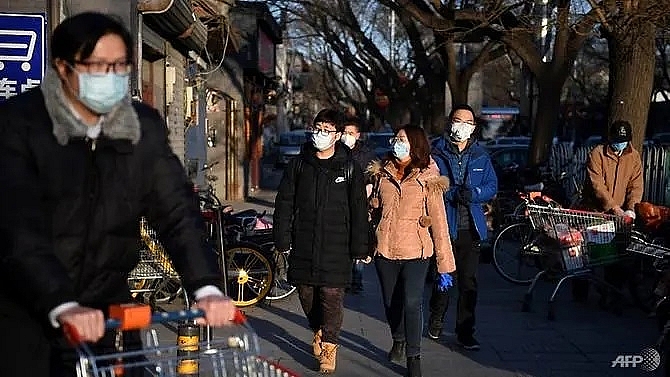Using lessons from SARS to combat new epidemic
 |
| People wear protective face masks as they arrive at a market in Beijing on Feb 17, 2020. (Photo: AFP/Greg Baker) |
With the coronavirus sweeping through China and its neighbouring countries like Vietnam, it is not only the spread of the dangerous virus that worries many people, but how it threatens economic growth prospects. In the 2002-2003 period, the widespread severe acute respiratory syndrome that originated in China killed some 800 people. Known as SARS, it decelerated the Chinese economy, slashing its annual growth rate to just over 9 per cent in the second quarter of 2003, from 11 per cent from the previous one, before eventually ending in June that year.
Also with a local outbreak of SARS at the time, Vietnam quickly acted to contain the outbreak within its borders and became the first country to be removed from the transmission list in April 2003.
The nation rounded up its first half with GDP adding 6.9 per cent, 0.4 percentage point higher than in the same period of 2002. The end of 2003 subsequently witnessed the GDP growth topping 7.24 per cent, a five-year record.
Picking up right after the virus was contained, the value of production and manufacturing rose by 15.7 per cent on-year in the first half of the year, data from the General Statistics Office showed. Exports swelled by 32.6 per cent on-year, taking up 48.7 per cent of total GDP. Climbing consumption was said to be the driving force behind the upbeat figures.
Capital mobilised for development was also up by more than 23 per cent on-year, with 70 per cent alone arriving from the domestic sector.
Tourism weathered a severe hit, rolling with an incessant drop in visitors as hotel occupancy rates barely met 30 per cent in the first two quarters. Yet promotions and campaigns were run aggressively by tourism authorities in a bid to entice tourists back in the remaining months. For the whole year, Vietnam welcomed some 2.4 million international visitors, equivalent to 89.4 per cent of the 2002 record, which was relatively strong performance, taking into account the lower tourism activity in the first quarter.
But can Vietnam do it this time when global economic growth is slowing down and the world is even more connected than it was 17 years ago? It is spring time, the season for various cultural festivals in Vietnam – yet many have been cancelled or shrank in scale to prevent the spread of the coronavirus.
Fewer tourists are seen in Hanoi these days, and it is the same for other prominent destinations including Danang, Halong Bay, Hoi An, and so on.
Many stores have extended their holiday until further notice. Shopping malls are almost empty, with the exception of supermarkets where people still come to stock up on food, groceries, and other necessities for everyday life.
Flights to and from China have been halted and visa issuance for international visitors who have previously travelled to China have also been provisionally suspended over the coronavirus concerns. The sector is indeed suffering, and the services, retail, and transportation industries trail along.
Undoubtedly, GDP growth in the first quarter of 2020 will be negatively impacted by lower tourism. The blow has been estimated by economists to take out up to 0.4 percentage point from the period’s GDP figure.
Factory disruptions in certain parts of China, meanwhile, will disrupt the global supply chain. Many local businesses now feel the pain after their intermediate parts imported from China were delayed at least until factories in China resume business. This will unfortunately take away another 0.4 percentage point from the projected GDP growth that Vietnam was looking forward to achieving.GDP growth of less than 6 per-cent could thus be expected for the first quarter.
But as past figures suggest, Vietnam can and will rebound vigorously as it has done once already, if the outbreak is quickly contained within weeks or months – and the government is making every effort for that.
Seventeen years on from the SARS epidemic, the world has seen the rise of advanced technologies which are reshaping the way we live and work.
Times when the fear of touching cash that could be contaminated with the virus is overcome by the use of e-wallets to make payments. Times when schools close to prevent infection risk, but students can attend online lessons and take tests. It is the era for humanity and disruptive technologies to learn to work together.
And it is time for Vietnam to reduce its reliance on China for intermediate inputs as local producers ought to seek for other markets to maintain production and find new markets for their agricultural exports.
This should be the time when the private sector in Vietnam enhances its involvement in the country’s development, as it is where the brain lies.
What the stars mean:
★ Poor ★ ★ Promising ★★★ Good ★★★★ Very good ★★★★★ Exceptional
 Tag:
Tag:
Related Contents
Latest News
More News
- Vietnam M&A Forum 2025: new position, new momentum (December 09, 2025 | 14:30)
- FDI in Vietnam jumps on additional capital and share purchases (December 09, 2025 | 13:56)
- VIR gathers dealmakers for M&A forum (December 08, 2025 | 17:17)
- Vietnam steps up green transformation with strong policies and rising investment demand (December 06, 2025 | 12:07)
- Listed companies honoured for information transparency (December 06, 2025 | 11:59)
- CSI 2025 highlights rise of Vietnam’s green champions (December 06, 2025 | 09:00)
- Vietnam strengthens energy storage pathway (December 04, 2025 | 15:05)
- OECD projects moderation in Vietnam’s GDP growth over next two years (December 03, 2025 | 15:22)
- Manufacturing growth holds steady despite storm disruptions (December 02, 2025 | 10:06)
- Sustainable Development Conference 2025 recognises leaders in green growth (November 28, 2025 | 16:18)
























 Mobile Version
Mobile Version